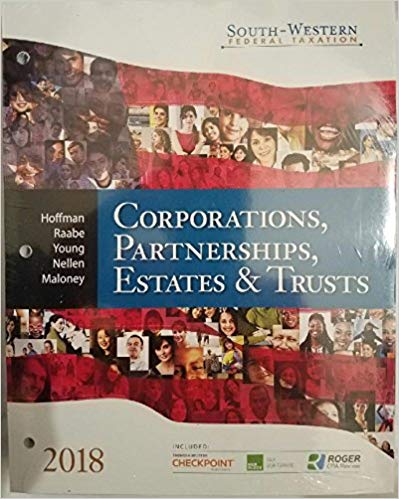Your client, Paul, owns a one-third interest as a managing (general) partner in the service-oriented PRE LLP.
Question:
Based on interim financial data and revenue projections, the LLP's balance sheet is expected to approximate the following at the end of the year.
-1.png)
Although the LLP has some cash, the amount is not adequate to purchase Paul's entire interest in the current year. The LLP has proposed to pay Paul, in liquidation of his interest, according to the following schedule.
December 31, 2018...........................$50,000
December 31, 2019...........................$50,000
December 31, 2020...........................$50,000
Paul has agreed to this payment schedule, but the parties are not sure of the tax consequences of the buyout and have temporarily halted negotiations to consult with their tax advisers. Paul has retained you to determine the income tax ramifications of the buyout and to make sure he secures the most advantageous result available. Using the IRS Regulations governing partnerships, answer the following questions.
a. If the buyout agreement between Paul and PRE is silent as to the treatment of each payment, how will each payment be treated by Paul and the partnership?
b. As Paul's adviser, what payment schedule should Paul negotiate to minimize his current tax liability?
c. Regarding the LLP, what payment schedule would ensure that the remaining partners receive the earliest possible deductions?
d. Under the three alternatives in parts (a) to (c), what is the present value of Paul's after-tax cash received from the buyout? Which alternative do you recommend to your client, Paul? Does this change your recommendations in parts (a) through (c)? Paul's Federal and state tax rate for capital gains is 25% and his rate for ordinary income is 40%. Assume also that Paul typically earns 6% on his investments (after-tax discount rate), and that the first payment will be received one year from now (with the other payments one year apart). Use the present value tables in Appendix F. Note that each year's after-tax cash flow differs, so the after-tax payment does not constitute an annuity. Create a spreadsheet that summarizes the after-tax cash flows and present values of the three alternatives. You might use the format below for part (a), where the partnership agreement is silent.
e. What additional planning opportunities might be available to the partnership?
-2.png)
Balance sheet is a statement of the financial position of a business that list all the assets, liabilities, and owner’s equity and shareholder’s equity at a particular point of time. A balance sheet is also called as a “statement of financial... Liquidation
Liquidation in finance and economics is the process of bringing a business to an end and distributing its assets to claimants. It is an event that usually occurs when a company is insolvent, meaning it cannot pay its obligations when they are due....
Step by Step Answer:

South Western Federal Taxation 2018 Corporations Partnerships Estates And Trusts
ISBN: 1389
41st Edition
Authors: William H. Hoffman, William A. Raabe, James C. Young, Annette Nellen, David M. Maloney





